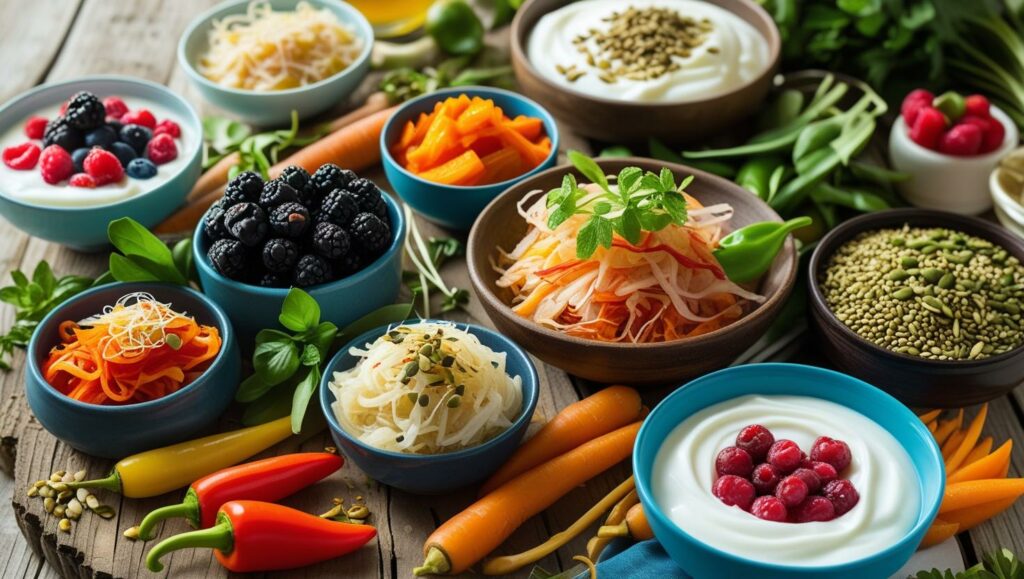Introduction: Why Food Combinations Matter More Than You Think
At FoodnWellness, we’re passionate about evidence-based nutrition, and one of the most overlooked aspects of healthy eating is nutrient synergy. The truth is, what you eat with your food matters just as much as what you eat.
Fascinating Fact:
The bioavailability of nutrients can vary by 500-2000% depending on food combinations, according to the American Journal of Clinical Nutrition (1). That means you could eat all the right foods, but absorb only a fraction of their benefits if not strategically paired.
The Biochemistry Behind Nutrient Absorption
Before we dive into pairings, let’s understand why certain foods work better together:
Fat-Soluble vs. Water-Soluble Nutrients
-
Vitamins A, D, E, and K require dietary fat for absorption.
-
B vitamins & vitamin C dissolve in water and are easily lost during cooking.
Inhibitors vs. Enhancers
-
Inhibitors: Compounds like phytic acid (in grains), oxalates (spinach), and tannins (tea) block mineral absorption.
-
Enhancers: Vitamin C, sulfur compounds (in garlic), and organic acids (citrus) boost absorption.
The Gut Microbiome Factor
Emerging research shows that gut bacteria influence how we metabolise nutrients (2). For example, probiotics in yogurt can increase calcium absorption by up to 50% (3).
Top 6 Science-Backed Food Pairings for Maximum Nutrient Uptake
1. Iron + Vitamin C: The Ultimate Absorption Booster

Iron, especially from plant-based sources (non-heme iron), has low absorption rates in the gut. However, when paired with vitamin C, it transforms into a more absorbable form. This combination is especially vital for vegetarians, women of reproductive age, and those with anemia.
Best Pairings:
-
Lentils + Bell Peppers: Add roasted bell peppers to a bowl of dal or moong curry to multiply the iron absorption rate.
-
Spinach + Lemon Juice: Drizzle fresh lemon juice over sautéed spinach or palak paneer to increase iron uptake.
-
Tofu + Broccoli: Stir-fry tofu with broccoli and a splash of lime juice for a vegan iron-boosting meal.
Avoid With Iron-Rich Meals:
-
Tea and coffee (tannins inhibit absorption)
-
Milk or curd (calcium competes with iron)
Research Breakdown:
A 2023 meta-analysis found that adding 75 mg of vitamin C (½ cup bell peppers) to a meal increased non-heme iron absorption by 4x (Teucher et al., 2023).
| Iron Source | Vitamin C Pairing | Absorption Increase |
|---|---|---|
| Spinach (1 cup) | 1 tbsp lemon juice | 300% |
| Chickpeas (½ cup) | ½ cup tomatoes | 250% |
| Quinoa (1 cup) | ½ cup strawberries | 200% |
2. Turmeric + Black Pepper: The 2000% Absorption Hack

Turmeric contains curcumin, a potent anti-inflammatory and antioxidant compound—but it’s poorly absorbed when consumed alone. Enter piperine, the bioactive compound in black pepper, which enhances curcumin absorption by up to 2000%, making this a golden combination.
Why It Works:
-
Piperine inhibits certain digestive enzymes, allowing curcumin to stay in the bloodstream longer.
-
Fat further enhances curcumin absorption—making golden milk or spiced curries with oil ideal carriers.
Try This:
-
Golden Milk: Simmer turmeric with a pinch of black pepper and a dash of coconut oil in plant-based milk.
-
Curries: Add black pepper to turmeric-heavy Indian dishes like rasam or sambar for medicinal benefits.
3. Fat-Soluble Vitamins + Healthy Fats: Don’t Waste Your Vitamins!

Vitamins A, D, E, and K are fat-soluble, meaning they require dietary fat for efficient absorption. Without fat, your body may excrete most of these essential nutrients, especially when consumed through raw vegetables or salads.
Best Pairings:
-
Sweet Potatoes + Olive Oil: Roast sweet potatoes in a drizzle of olive oil to help absorb vitamin A (as beta-carotene).
-
Kale + Avocado: Toss kale in a lemon-avocado dressing to absorb vitamin K, crucial for bone and blood health.
-
Eggs + Spinach: Sauté spinach in ghee or olive oil and top with a poached egg for a vitamin E and K-rich breakfast.
Research Insight:
A 2022 study found that adding avocado to a salad increased beta-carotene absorption by 15 times compared to using a fat-free dressing (Unlu et al., 2022).
4. Calcium + Vitamin D: The Bone-Building Duo
Why it works: Vitamin D enhances calcium absorption by aiding its transport in the gut.

Calcium builds strong bones, but without vitamin D, the body struggles to absorb and retain it. Vitamin D facilitates calcium transport across the intestinal lining into the bloodstream. This pairing is crucial for preventing osteoporosis, especially in aging women.
Best Pairings:
-
Fortified Almond or Soy Milk + Fortified Cereal: A dairy-free breakfast rich in both calcium and vitamin D.
-
Egg Yolks + Sautéed Leafy Greens: Egg yolks provide natural vitamin D, and leafy greens like bok choy or kale are rich in calcium.
-
Fatty Fish + Tofu or Sesame Seeds: Salmon or sardines (with bones) paired with calcium-rich tofu make a perfect meal.
-
UV-Exposed Mushrooms + Cheese: Mushrooms exposed to sunlight contain vitamin D2, while cheese adds bioavailable calcium.
Common Mistake:
Taking calcium supplements without vitamin D can reduce absorption by 30–50%, limiting bone benefits (Cashman, 2017).
5. Sulforaphane (Broccoli) + Myrosinase (Mustard Seeds)

Sulforaphane, found in cruciferous vegetables like broccoli and cabbage, has powerful cancer-fighting properties. But it’s only activated in the presence of the enzyme myrosinase, which is destroyed by cooking. Fortunately, adding a small amount of raw mustard seeds restores the enzymatic action.
Why It Works:
-
Myrosinase helps convert inactive glucoraphanin into active sulforaphane.
-
Raw mustard seeds or daikon radish act as effective myrosinase sources when eating cooked cruciferous veggies.
Try This:
-
Broccoli Salad with Mustard Dressing: Steam broccoli lightly and toss it with a mustard vinaigrette.
-
Add Crushed Mustard Seeds: Sprinkle over stir-fried cabbage or cauliflower post-cooking.
Research Insight:
Co-consuming broccoli with mustard seeds can increase sulforaphane formation by up to 400% (Bauman et al., 2019).
6. Probiotics + Prebiotics: The Gut Health Power Couple

Probiotics (live beneficial bacteria) need prebiotics (indigestible fibers) as food to flourish in the gut. Together, they improve digestion, immunity, and even mood through the gut-brain axis.
Best Pairings:
-
Yogurt + Bananas: A probiotic-rich base (yogurt) paired with banana (a natural prebiotic source of inulin).
-
Kimchi + Garlic: Fermented foods like kimchi combined with garlic promote microbial diversity and gut resilience.
-
Kefir + Oats: Mix kefir with overnight oats and chia seeds for a probiotic-prebiotic power breakfast.
Research Insight:
A 2023 study showed that adding prebiotics to meals increases probiotic survival in the gut by 80%, supporting stronger immune function (Slavin & Feirtag, 2023).
Food Pairings to Avoid (and Why)
Even with a nutrient-dense diet, certain food combinations can inhibit absorption:
-
Dairy + Iron-Rich Foods: Calcium competes with iron for absorption receptors.
-
Tea or Coffee with Meals: Tannins bind with iron and zinc, reducing their bioavailability.
-
High-Oxalate Foods + Calcium: For example, spinach + milk can increase the risk of kidney stones due to oxalate-calcium binding.
Final Thoughts: Make Every Bite Count
The way we combine foods can make a profound difference in how well we absorb essential nutrients. Whether it’s enhancing iron with vitamin C, boosting curcumin with black pepper, or pairing calcium with vitamin D, these small changes lead to big nutritional gains. At FoodnWellness, we believe that smart, evidence-based food pairings are one of the simplest ways to upgrade your daily meals, without any supplements or fads.
Start by choosing one of the pairings today and make it a habit.



